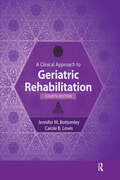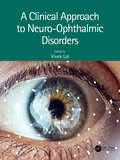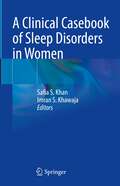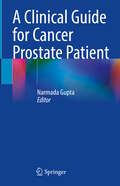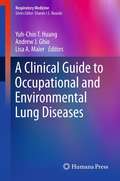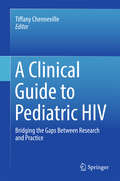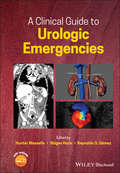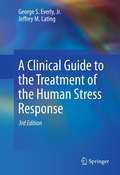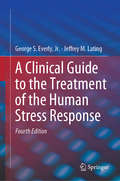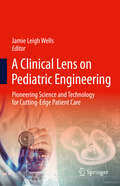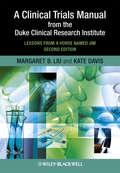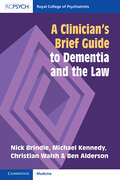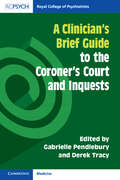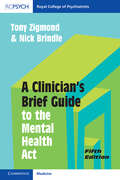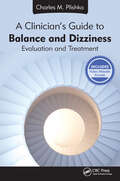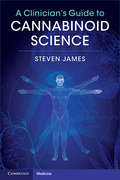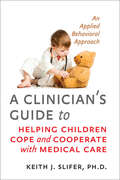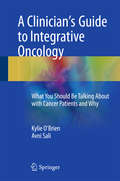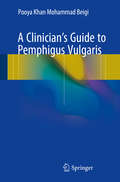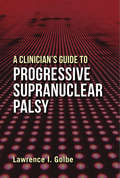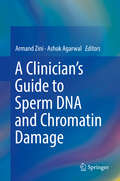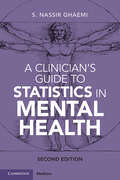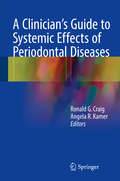- Table View
- List View
A Clinical Approach to Geriatric Rehabilitation
by Carole Lewis Jennifer BottomleyThe field of geriatric rehabilitation is constantly changing due to the discovery of new evidence-based evaluation and treatment strategies, as well as the continual support or refutation of older theories and practices. Now in itsFourth Edition, A Clinical Approach to Geriatric Rehabilitation has been updated to be at the forefront of these changes and includes free video content from MedBridge and a discount on a MedBridge subscription to geriatric rehabilitation courses offered by the authors.Drs. Jennifer M. Bottomley and Carole B. Lewis have compiled the plethora of available scientific research on geriatric populations and combined it with their years of actual clinical practice. Together this makes this text a complete evidence-based guide to the clinical care of geriatric patients and clients.The first part of A Clinical Approach to Geriatric Rehabilitation, Fourth Edition tackles applied gerontological concepts, providing the general knowledge base necessary for treating geriatric patients. Topics in this section include patient evaluation, an exploration of nutritional needs, and age-related changes in physiology and function, as well as many other foundational areas.In the second section, topics become more focused on patient care concepts like neurologic considerations, cardiopulmonary and cardiovascular considerations, and establishing community-based screening programs.In the final section, chapters center on administration and management, including important subjects such as attitudes, ethics, and legal topics, as well as consultation and research.New and updated in the Fourth Edition: Pearls section for succinct highlights of the content within each chapter The latest evidence-based practice interventions with complete references for further reading Updated graphics, pictures, and diagrams to illustrate the content Content summaries and streamlined text for enhanced readability Updated case studies to exemplify clinical decision-making Designed to provide valuable, real-life clinical knowledge, A Clinical Approach to Geriatric Rehabilitation, Fourth Edition gives physical therapists an evidence-based guide to the clinical aspects of rehabilitative care in older adult patients and clients.
A Clinical Approach to Neuro-Ophthalmic Disorders
by Vivek LalNeuro-ophthalmology is a merged subspecialty of neurology and ophthalmology dealing with complex multisystem diseases presenting with visual manifestations. This book helps the reader in recognizing, approaching, and managing such a patient. It covers the afferent and efferent systems, pupillary disorders, and Radiology of neuro-ophthalmic conditions. It features individual symptomatology with salient points, their management and differential diagnosis. It has case scenarios, key points, and algorithms along with self-assessment MCQ questions. Its simplified, step wise approach will be a useful resource for neurologists, ophthalmologists, physicians, pediatricians, and optometrists. Key Features• Features a simplified and stepwise clinical approach to neuro-ophthalmic disorders.• Includes case studies and clinical pearls along with self-assessment sections.• Covers to the point and crisp analysis of common complaints faced in neuro-ophthalmology. All the royalties of this book are donated to the Poor Patients Cell of PGIMER, Chandigarh.
A Clinical Casebook of Sleep Disorders in Women
by Imran S. Khawaja Safia S. KhanSleep disorders are very common among women during their lifespan, presenting in isolation or in combination with other illnesses particularly psychiatric and neurologic disorders. Pregnancy-related sleep disorders pose an interesting dilemma as this is a transient phase; these are associated with potential long-term effects on maternal and fetal health. Menopause and pre-menopausal stages lead to a significant change in sleep architecture, sometimes associated with insomnia with or without sleep related breathing disorder. Sleep architecture in men and women varies due to significant hormonal differences between the genders. However, sleep complaints are disproportionately higher among women. This book presents 20 clinical cases to understand the differences in presentation of symptoms and treatment options for various sleep disorders that are more commonly noted among women. These cases cover a spectrum of sleep related breathing disorders, sleep related movement disorders, hypersomnias, parasomnias, issues of sleep fragmentation leading to insomnia in association with hormonal changes and some unique cases encountered in our clinical practices. This compilation of interesting clinical cases presents trainees and experienced physicians with a useful guide to assist in their clinical practices and will stimulate further research and studies.
A Clinical Guide for Cancer Prostate Patient
by Narmada GuptaThis book imparts a thorough understanding of the proper diagnosis, evaluation, and management of a patient with prostate cancer. The book provides guidelines for evaluation and investigation to reach a diagnosis with appropriate risk stratification of the disease, which is essential to evaluate the patient's survival and quality of life after the treatment. The book offers assistance, as per the patient and disease factors, appropriate treatment planning for an individual patient, and treatment outcomes for a better follow-up. This book aims to cover all aspects of prostate cancer with an additional supplement to the existing books in urology. This book targets postgraduates in urology, oncology, uro-oncology, practicing urologists, oncologists, and prostate cancer patients to know all aspects of the disease.
A Clinical Guide for Management of Overweight and Obese Children and Adults (Modern Nutrition Science)
by Caroline M. Apovian Carine M. LendersWhile unhealthy diet and sedentary behaviors are second only to smoking as the leading preventable cause of death in the U.S., less than 45 percent of adult and pediatric obese patients received any prior advice from a physician to lose weight. The low rate of identification and treatment of obesity by physicians can often be attributed to lack of
A Clinical Guide to Occupational and Environmental Lung Diseases (Respiratory Medicine)
by Andrew J. Ghio Yuh-Chin T. Huang Lisa A. MaierA Clinical Guide to Occupational and Environmental Lung Diseases delivers a concise compendium to the diagnosis and management of occupational and environmental lung diseases, incorporating evidence-based guidelines where available. Each chapter provides an updated review and a practical approach to different occupational and environmental lung diseases. With rapidly changing technology, new conditions and exposures will undoubtedly emerge. Clinicians need to remain vigilant about assessing the potential link between lung diseases and environmental exposures, and this book provides a practical guide to recognize, diagnose, and prevent occupational and environmental lung diseases. Written for practicing clinicians including internists, pulmonologists, and primary care providers, as well as industrial hygienists and environmental regulators, A Clinical Guide to Occupational and Environmental Lung Diseases is a timely and important new volume and an invaluable contribution to the literature.
A Clinical Guide to Pediatric HIV: Bridging the Gaps Between Research and Practice
by Tiffany ChennevilleThis book examines the impact of pediatric HIV on children, adolescents, and their families. Beginning with an overview of pediatric HIV epidemiology, it traces the medical, psychological, and social dimensions of HIV through the trajectory of childhood and youth. It examines the latest research on a wide range of topics, including treatment adherence, cultural, legal, and ethical issues, and HIV stigma and its reduction. Chapters offer expert recommendations for clinicians working with children with HIV as well as researchers studying pediatric HIV. In addition, the book also discusses daily concerns associated with pediatric HIV, such as disease management, coping, access to services, risk prevention, and health promotion. Topics featured in this book include: The impact of pediatric HIV on families. Psychosocial considerations for children and adolescents with HIV. HIV prevention and intervention in the school setting. HIV disclosure in pediatric populations. How to design effective evidence-based HIV risk-reduction programs for adolescents. A Clinical Guide to Pediatric HIV is a must-have resource for researchers, clinicians, and graduate students in child and school psychology, social work, and public health as well as pediatric medicine, nursing, epidemiology, anthropology, and other related disciplines.
A Clinical Guide to Urologic Emergencies
by Hunter Wessells Shigeo Horie Reynaldo G. GómezA Clinical Guide to Urologic Emergencies A Clinical Guide to Urologic EmergenciesAn ageing population and a predicted shortfall in the number of urologists means that, increasingly, the management of complex urological problems will fall to hospital emergency departments and the surgeries of primary care physicians. With many doctors and medical students now having less exposure to urology, there is a real and urgent need for accessible and practical guidance in managing urologic emergencies.A Clinical Guide to Urologic Emergencies offers practical guidance to the best practices in diagnosis, treatment and management of patients with urgent urological conditions. Designed to be an extremely useful tool to consult in the clinical setting, it will be a vital source of information and guidance for all clinicians, irrespective of their level of urologic knowledge.Edited by an outstanding international editor team, this book is particularly aimed at physicians, advanced practice providers, and urology and emergency medicine trainees managing patients in diverse healthcare settings across the globe.A Clinical Guide to Urologic Emergencies is accompanied by a website featuring video content at www.wiley.com/go/wessells/urologic
A Clinical Guide to the Treatment of the Human Stress Response (Springer Series On Stress And Coping Ser.)
by George S. Everly Jr. Jeffrey M. LatingThis new edition emphasizes the unique contribution of this longstanding text in the integration of mind/body relationships. The concept of stress, as defined and elaborated in Chapter 1, the primary efferent biological mechanisms of the human stress response, as described in Chapter 2, and the link from stress arousal to disease, as defined in Chapter 3, essentially remains the same. However, updates in microanatomy, biochemistry and tomography are added to these chapters. All other chapters will be updated as well, as there has been significant changes in the field over the past eight years.
A Clinical Guide to the Treatment of the Human Stress Response (Springer Series On Stress And Coping Ser.)
by Jeffrey M. Lating George S. Everly, Jr.This comprehensive update of the now classic text applies the most current findings across disciplines to the treatment of pathogenic human stress arousal. New and revised chapters bring together the art and science of intervention, based in up-to-date neuroscience, starting with an innovative model tracing the stress-to-disease continuum throughout the systems of the human body. The authors detail the spectrum of physiological and psychological treatments for the stress response, including cognitive therapy, neuromuscular relaxation, breathing exercises, nutritional interventions, and pharmacotherapy. They also assess the strengths and limitations of widely-used measures of the stress response and consider the value of personality factors, cultural considerations, and resilience in stress mediation.Included in the coverage:The anatomy and physiology of the human stress response.Advances in neuroscience: implications for stress.Crisis intervention and psychological first aid.Neurophysiological rationale for the use of the relaxation response.Physical exercise and the human stress response. The pharmacological management of stress reactions. Disaster Mental Health Planning.Cultural Awareness and Stress.The Fourth Edition of A Clinical Guide to the Treatment of Human Stress Response offers readers a dual perspective, exceedingly useful in examining the origins of the stress response, and in preventing and treating the response itself. This rich integrative volume will join its predecessors in popularity among practitioners and students across disciplines and specialties.
A Clinical Lens on Pediatric Engineering: Pioneering Science and Technology for Cutting-Edge Patient Care
by Jamie Leigh WellsA Clinical Lens on Pediatric Engineering: Pioneering Science and Technology for Cutting-Edge Patient Care explores the depth and breadth of the newly applied science of pediatric engineering and its dawning era. Placing into context the origins of pediatric medicine and engineering, this deep dive into and beyond medical digital-to-device innovation integrates scientific rigor with clinical perspective, incorporating case examples of diagnostic and therapeutic breakthroughs, cautionary tales, and lessons in translation. The book begins by explaining the unique considerations of the developing child and the importance of including nuanced end-user and human factors early and often in the process of seeking biomedical solutions. It provides an overview of this population's diverse and dynamic biopsychosocial characteristics compared to adults, contrasting organ systems, cognitive maturation, bioethics, growth, and drug metabolism. A distinguished team of contributors supplies a comprehensive blueprint for transforming an idea through to clinical implementation, featuring the ever-expanding influences and intricacies of discovery. The book covers a wide array of topics, including fetal intervention, transplantation, regenerative medicine, addiction, ophthalmology, surgery (e.g., minimally invasive, orthopedic), cancer, nanotechnology, radiology imaging modalities, gene therapy, artificial intelligence (AI), machine learning, liquid biopsy, immersive technologies (e.g., augmented and virtual reality), neurodiversity, rare disease, critical care, robotics, materials science and tissue engineering. The design challenges specific to children’s hospitals and healthcare facilities are discussed, highlighting the flexibility needed to achieve optimal patient outcomes, gather meaningful data, and drive innovative progress. This landmark work calls on key stakeholders to address the obstacles related to funding practices, clinical trials, and other impediments that hinder the timely and safe delivery of life-altering and life-saving results. It provides child health innovators with the essential tools to bridge these gaps and drive transformation in the rapidly evolving landscape of pediatric care.
A Clinical Trials Manual From The Duke Clinical Research Institute: Lessons from a Horse Named Jim
by Margaret Liu Kate Davis"The publication of the second edition of this manual comes at an important juncture in the history of clinical research. As advances in information technology make it possible to link individuals and groups in diverse locations in jointly seeking the answers to pressing global health problems, it is critically important to remain vigilant about moral and ethical safeguards for every patient enrolled in a trial. Those who study this manual will be well aware of how to ensure patient safety along with fiscal responsibility, trial efficiency, and research integrity." —Robert Harrington, Professor of Medicine, Director, Duke Clinical Research Institute, Durham, North Carolina, USA The Duke Clinical Research Institute (DCRI) is one of the world's leading academic clinical research organizations; its mission is to develop and share knowledge that improves the care of patients around the world through innovative clinical research. This concise handbook provides a practical "nuts and bolts" approach to the process of conducting clinical trials, identifying methods and techniques that can be replicated at other institutions and medical practices. Designed for investigators, research coordinators, CRO personnel, students, and others who have a desire to learn about clinical trials, this manual begins with an overview of the historical framework of clinical research, and leads the reader through a discussion of safety concerns and resulting regulations. Topics include Good Clinical Practice, informed consent, management of subject safety and data, as well as monitoring and reporting adverse events. Updated to reflect recent regulatory and clinical developments, the manual reviews the conduct of clinical trials research in an increasingly global context. This new edition has been further expanded to include: In-depth information on conducting clinical trials of medical devices and biologics The role and responsibilities of Institutional Review Boards, and Recent developments regarding subject privacy concerns and regulations. Ethical documents such as the Belmont Report and the Declaration of Helsinki are reviewed in relation to all aspects of clinical research, with a discussion of how researchers should apply the principles outlined in these important documents. This graphically appealing and eminently readable manual also provides sample forms and worksheets to facilitate data management and regulatory record retention; these can be modified and adapted for use at investigative sites.
A Clinician's Brief Guide to Dementia and the Law
by Michael Kennedy Nick Brindle Christian Walsh Ben AldersonDementia is a topic of enormous medical, legal and ethical importance with considerable human and economic cost. Its importance grows with the change in demographics of the aging population and that people with dementia receive care in a wide range of settings. The legal and ethical problems raised in treating patients with dementia are diverse and complex and are dealt with by many practitioners on a daily basis. This book is a 'how-to' guide to understanding how the law applies to people with dementia, from diagnosis through to end-of-life. It explores the practical problems that people experience, and practitioners face, giving an accurate account of statute, court cases and other inquiries, to give readers an up-to-date account of the law and how it applies in this area. An essential read for clinicians and practitioners that work with patients with dementia, including psychiatrists, primary care physicians, nurses, social workers and advocates.
A Clinician's Brief Guide to the Coroner's Court and Inquests (A Clinician's Brief Guide)
by Gabrielle Pendlebury Derek TracyThe sudden and unexpected death of a patient can be emotionally complex and overwhelming for clinicians. This book will equip medical and other healthcare professionals with the necessary information and skills to fulfil their requirements in the coroner's court confidently and competently and understand their organisation's responsibilities. Practical and straightforward, this book aims to make the unfamiliar territory of the coroner's court transparent, enabling clinicians to negotiate all eventualities. It will provide clinicians with the confidence to turn what can feel like an adversarial situation into an opportunity to engage with an important part of the healthcare system, preventing future deaths and providing understanding to relatives. It also explores the underlying necessity of complying with requirements and suggests ways to cope with the emotional impact. With chapters covering expert witnesses, legal perspectives and managing outcomes, this book is essential for any healthcare professional called to an inquest.
A Clinician's Brief Guide to the Mental Health Act (A Clinician's Brief Guide)
by Tony Zigmond Nick BrindleA 'how to' book guiding clinicians through the mental health legislation that they need to understand and use in their daily practice, covering the Mental Health Act 1983 and subsequent amendments. This revised and updated edition incorporates new acts, such as the Policing and Crime Act 2017 and Mental Capacity (Amendment) Act 2019. It also covers the findings and implications from Professor Sir Simon Wessely's 2018 review of the Mental Health Act in a new chapter. Written by two leading psychiatrists with many years of experience in using the mental health legislation and in running mental health law courses, this book outlines how changes to statutes and case law have a direct bearing on day-to-day psychiatric practice and why it is important that clinicians of all disciplines have access to and understand the legislation. This is the go-to guide for all clinicians, doctors and nurses working in mental health services.
A Clinician's Guide to Balance and Dizziness: Evaluation and Treatment
by Charles M. PlishkaWith an increasing number of referrals to treat balance impairment, gait disorders, and dizziness, A Clinician’s Guide to Balance and Dizziness: Evaluation and Treatment by Dr. Charles M. Plishka looks to address these issues and provides tests, measures, and interventions that are matched to research studies when available, for evidence-based practice. It begins with a review of the anatomy and physiology of the systems used to balance. With a basic understanding of how we balance, the signs and symptoms of patients will be understood with much greater ease.A Clinician’s Guide to Balance and Dizziness enables the reader to perform a complete and thorough evaluation and helps to provide treatment options for identified deficits that place the patient at risk for falls. Along with numerous diagrams and photos, this text comes with access to a web site containing video clips that demonstrate key evaluation and treatment techniques. The result will be a better evaluation, treatment plan, and outcome.Topics and Features Include: How do we balance? Tests to evaluate the balance-impaired patient Tests and interventions for conditions such as Benign Paroxysmal Positional Vertigo (BPPV), Vestibular Loss, and the central and peripheral causes of dizziness Therapy treatments “How to” instructions throughout Companion web site with video clips demonstrating evaluation and treatments A Clinician’s Guide to Balance and Dizziness: Evaluation and Treatment is an easy-to-use reference perfect for professionals who assess and treat balance impairments and dizziness. While it is an instructional text for physical therapy students and clinicians, it is also a great reference for established physicians, vestibular and balance therapy specialists, occupational therapists, nurse practitioners, physician assistants, audiologists, and athletic trainers.
A Clinician's Guide to Cannabinoid Science
by Steven JamesMedical marijuana and the promise of medical advances with cannabinoids is a controversial topic. This book provides clinicians with credible, peer-reviewed science to advise patients on the use of cannabinoids in practice. From the history of cannabis to the recent discoveries, chapters include the science of cannabinoids, changes in the legal and regulatory landscape, and the emerging area of endocannabinoids. The book differentiates approved cannabinoids from cannabis and medical marijuana and stimulates clinicians to think about the risks and benefits of these two drugs. It provides the factual background for clinicians to lead the discussion on the continued use of marijuana, ongoing areas of research and future advances and development of new medications for treatment. An invaluable guide for all specialists in the pharmaceutical sciences, toxicologists, biochemists, neurologists, psychiatrists, addiction specialists, as well as primary care physicians, nurse practitioners, and regulators and policymakers.
A Clinician's Guide to Helping Children Cope and Cooperate with Medical Care: An Applied Behavioral Approach
by Keith J. SliferHow adults can help children cope with routine and traumatic medical care.Keith J. Slifer, a pediatric psychologist at the Kennedy Krieger Institute and the Johns Hopkins University School of Medicine, explores how adults can help children cope with routine and traumatic medical care. He draws on practice and research to help health care practitioners provide better care for children with chronic conditions and children undergoing rehabilitation after traumatic injury or surgery. By better understanding the behavior, emotions, and developmental challenges of children, health care professionals in practice and in training can solve a range of problems, from getting a distressed child to cooperate with a physical examination or diagnostic test, to teaching a child to adhere to medical self-care.More than 9 million children in the United States regularly visit health care professionals for treatment of chronic or recurrent health conditions. These children experience multiple doctors’ visits, trips to the emergency department, hospital admissions, anesthesia, surgery, medications, needle sticks, wound cleaning, seizures, nausea, vomiting, pain, and fear. While most of these children are developing typically in terms of their intellectual and cognitive functioning, many children with intellectual, developmental, and physical disabilities also require frequent medical care, and as chronic health conditions increase, so do the chances of having developmental, learning, emotional, and behavioral problems.A Clinician's Guide to Helping Children Cope and Cooperate with Medical Care will benefit health care professionals and children as practitioners aim both to improve medical care and to prevent the children’s behavior from disrupting clinics and distressing and frustrating health care workers and family caregivers. This book is for pediatric psychologists, pediatricians, family medicine practitioners, physician’s assistants, nurse specialists, pediatric subspecialists, and students in these fields—and for family members dedicated to helping their children cope with medical procedures and to getting the best possible medical care.
A Clinician's Guide to Integrative Oncology: What You Should Be Talking About with Cancer Patients and Why
by Kylie O'Brien Avni SaliThis book is the definitive guide for oncologists, general medical practitioners and other healthcare professionals with an interest in integrative oncology. Guiding you on how to conduct the "ultimate consultation" from an integrative medicine perspective, this text is a valuable educational tool, presenting the latest evidence-based approaches to managing the cancer patient, as well as anecdotes and practical recommendations from Dr. Sali's decades of clinical experience as a leading expert in integrative oncology. Topics include the role of mind-body medicine in cancer, stress reduction, diet, sleep, sunshine and Vitamin D, exercise, vitamins and other supplements, supportive complementary medicines including Chinese herbal medicine and acupuncture, and innovative investigative and treatment technologies. Written by two clinicians who are also educators and researchers, A Clinician's Guide to Integrative Oncology provides practical, evidence-based information and patient advice that clinicians can put into practice immediately.
A Clinician's Guide to Pemphigus Vulgaris
by Pooya Khan Mohammad BeigiGiving dermatologists, dermatology residents, and primary care physicians a deeper insight into pemphigus vulgaris, a rare autoimmune disease characterized by blisters and lesions on the skin and mucous membranes, this book provides insight and treatment options alongside dozens of high quality photographs, pathology slides, illustrations, algorithms, figures and clinical tables detailing the disease at all stages. Providing more than 20 clinical case photos of patients exhibiting symptoms, A Clinician's Guide to Pemphigus Vulgaris summarizes much of what is known about this disease, including categories of the disorder, clinical symptoms, diagnosis and treatment, and recent clinical research photos about the disease.
A Clinician's Guide to Progressive Supranuclear Palsy
by Lawrence I. GolbeThis brief, clinically-focused volume is informed by Lawrence I. Golbe’s three decades of research and tertiary clinical care in progressive supranuclear palsy, a complex disorder with rapidly changing diagnostic and therapeutic approaches. It is an ideal source for the general neurologist seeking a refresher and the primary care provider, neurological nurse, or physical, occupational or speech therapist who must address their patients’ specialized needs. A Clinician’s Guide to Progressive Supranuclear Palsy emphasizes early diagnostic signs, medication options, non-pharmacologic management and palliative care. It offers a quick overview of the complications of PSP most likely to prompt an ER visit; a widening spectrum of PSP variants; and ample description of the genetics, epidemiology, natural history, pathology, molecular biology and neurochemistry of PSP. The PSP Rating Scale used in the book is a convenient tool for clinicians in routine practice and the leading PSP clinical measure world-wide. Golbe provides a practical and useful guidebook to help all clinicians learn and battle this complex disorder.
A Clinician's Guide to Pulmonary Arterial Hypertension
by Simon StewartPulmonary arterial hypertension (PAH) is a relatively rare but potentially life-threatening disease. In most forms, the disease is likely to be diagnosed late and is associated with progressive clinical deterioration and premature death. A Clinician's Guide to Pulmonary Arterial Hypertension, Second Edition enhances the overall PAH awareness of the
A Clinician's Guide to Sperm DNA and Chromatin Damage
by Ashok Agarwal Armand ZiniThis comprehensive, up-to-date text, which brings together the key practical elements of the rapidly evolving field of sperm DNA and chromatin abnormalities, is divided thematically into five main sections. Part I discusses human sperm chromatin structure and nuclear architecture, while part II presents laboratory evaluation of sperm DNA damage, including SCSA, SCD, TUNEL and Comet assays, and cytochemical tests. Biological and clinical factors in the etiology of sperm DNA damage are discussed in part III, including oxidative stress, abortive apoptosis, cancer, and environmental and lifestyle factors. Part IV presents clinical studies on the utility of sperm DNA damage tests, both with natural and ART-assisted pregnancies, and debates the clinical utility of such tests. Finally, part V discusses current treatment options, such as antioxidant therapy, varicocelectomy, advanced sperm processing techniques and the use of testicular sperm. We are now beginning to better understand the unique organization of the sperm chromatin, as well as the nature and etiology of sperm DNA damage. Written and edited by worldwide experts in andrology, A Clinician's Guide to Sperm DNA and Chromatin Damage is an excellent resource for reproductive medicine and REI specialists, urologists, reproductive biologists and any professional working with the infertile male.
A Clinician's Guide to Statistics in Mental Health: Measuring Truth And Uncertainty
by S. Nassir GhaemiThe second edition of a clear and accessible guide to the application of statistics in psychiatric practice. The book expertly describes statistical concepts in clear and simple terms, with minimal mathematical content, making it the ideal resource for busy mental health professionals. Fully revised throughout, it features five new chapters covering key advances in the field and important topics in greater detail. Amongst the key concepts discussed in this edition are the logic of randomization, clinical trials, the overuse of p-values, understanding effect sizes, meta-analysis and why clinical experience is limited by observational confounding bias. Featuring a wealth of clinical examples, on topics of high importance or controversy in psychiatry, plus explanations and reasoning, to give clinicians a better understanding of how to apply research to their practice.
A Clinician's Guide to Systemic Effects of Periodontal Diseases
by Ronald G. Craig Angela R. KamerA Clinician's Guide to Systemic Effects of Periodontal Diseases will serve as an ideal, easy-to-use reference for the practicing health professional. It summarizes the latest research on the systemic effects of periodontal diseases, discusses how the results of this research will impact on clinical practice, and aims to help the clinician to answer questions that may be posed by patients, medical colleagues, and the media. A central theme is the contribution of periodontal diseases to systemic inflammation but other mechanisms, such as systemic dissemination of oral pathogens, are also covered. A collaborative approach involving noted investigators in each field and medical colleagues ensures that all chapters are of clinical relevance from both a dental and a medical perspective. The book is also visually engaging, with numerous summary figures and graphics, bullet point tables, and highlight boxes identifying the most clinically significant points.
